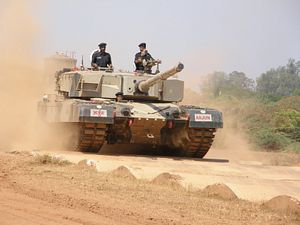As the crisis between India and Pakistan that began earlier this month is showing no signs of quickly dissipating, here is a quick rundown of the main battle tank (MBT) forces of the two rivals in South Asia as a number of reports have emerged that both sides have activated and reinforced their heavy armor formations along the Line of Control and regular border.
India
The Indian Army currently fields over 3,000 MBTs divided into 67 armored regiments. However, the MBT force remains in poor shape. The backbone of the force remains 1,900 T-72M1 Ajeyas imported in the 1980s, 1,500 of which are slated to be retrofitted with more powerful engines, new fire control systems, reactive armor, fire detection and suppression systems, as well as new communication and navigation systems under the Combat Improved Ajeya program, code-named Project Rhino. About 300 T-72M1s have reportedly been upgraded to date. Over 50 percent of the T-72M1 force is thought to be incapable of combat operations as of December 2018.
The service also operates two more advanced variants of the third-generation Russian T-90 MBT — the T-90S Bhishma and T-90SM (other designations T-90AM or T-90MS). The first T-90S MBTs were delivered to India in January 2004. There are currently around 1,000 T-90S MBTs of both variants in service, although the operational readiness rate of the tanks is unclear. The majority of T-90s are of the T-90S variant, with one estimate putting the total number at 850-900. The Indian Army is currently in the process of procuring an additional 464 T-90SM MBTs. India plans to field a total T-90S and T-90SM MBT force of over 1,600 by the early 2020s.
Furthermore, the Indian Army operates the Arjun MK-I tank, an indigenously developed MBT based on the German Leopard II tank design, of which anywhere from 80 to 124 (depending on the sources) have been handed over to the service to date. Notably, over 50 percent of Arjun MK-I MBTs reportedly remain grounded due to various technical problems. The Army has also accepted an improved version of the Arjun MBT, designated Arjun MK1-A, into service. The new version reportedly has a total of 14 new upgrades over the existing version. These include an auto-target tracker, an automatic gear system, and an upgraded suspension system.
Interestingly, “India’s MoD issued a global request for information (RFI) in November 2017 to develop and build 1,770 armored fighting vehicles, principally to replace the Indian Army’s T-72 MBTs in the next decade,” I wrote in October 2018. “A request for proposal (RFP), the next stage in the procurement process, however, has not been issued to date.”
Pakistan
The Pakistani Army’s MBT force is more diverse. Overall, the service fields approximately 2,400 MBTs divided up into around 50 armored regiments. The bulk of the force (1,100) consists of the Type-59/Al-Zarrar, a second-generation battle tank based on the Chinese Type 59 MBT, which in turn was based on the Soviet T-54A. It also still operates around 50 older T-54/T-55 MBTs. The Army also continues to operate 400 Type-69 II MBTs, which were license-built in Pakistan based on Chinese designs and first entered service in the 1980s. Additionally, the Army deploys around 270 Type-85 IIAPs, second-generation Chinese-designed MBTs.
Furthermore, the Army operates 350 al-Khalid MBTs, a joint development by Pakistan and China in 1990s, based on the Chinese Type 90-IIM tank, with the first prototype developed by China North Industries Corporation (NORINCO) under the name MBT-2000. The service also deploys over 20 upgraded al-Khalid I MBTs. Pakistan is reportedly also working on a more advanced version, designated al-Khalid III MBT.
Pakistan Army’s also operates the T-80UD MBT, an improved variant of the Soviet-made T-64 MBT, was first introduced into service with the Pakistan Army in the late 1990s. Pakistan received a total of 320 tanks from Ukraine from the 1997 to 2002. Ukraine’s largest state-owned defense contractor is currently upgrading the Army’s T-80 force.
It is unclear whether the retrofitting of the fleet has already begun. “Pakistan’s T-80UD tanks could be upgraded to the standards of the T-84 ‘Oplot-M’ MBT, a much-improved variant of the T-84 (which in turn is an improved version of the T-80), featuring a larger turret mounting sophisticated sensors and, among other things, a panoramic thermal-imaging system,” I wrote elsewhere.
There also have been reports that the Army intents to induct Chinese-made MBT3000/VT-4 MBTs. The VT-4 is a third-generation MBT that incorporates technology from China’s ZTZ-99/ZTZ-99A MBT. The VT-4 is based on the al-Khalid series, but unlike al-Khalid tanks, it is fitted with a Chinese-made engine.
The overall operational readiness rate of the Pakistan Amy Armored Corps is generally not known.

































